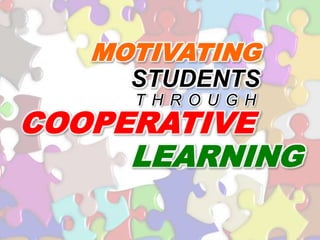Cooperative Learning { Applied } by Xaris Villa
- 2. Teaching ScenarioP.5 Class (Ability: Average)Reading motivation is low. No interest in content of reader (i.e. wolves and bears)Unfamiliar text type (informational report)Ability to search for information is inadequate.Students have no confidence in writing something they have never written before.When working in groups: student participation and involvement is erratic.
- 3. SolutionsFrom Cooperative Learning Approach
- 4. PositiveInterdependenceGroupProcessingIndividualAccountabilitySocialSkillsFACE to face Interaction
- 5. Classroom Set Up(Get the students to face each other!)FACE to face Interaction
- 6. Classroom Set Up(the focus on groups becomes more obvious)Plan Group Activities
- 7. Give Freedom for Groups.
- 8. Reward in groups.FACE to face Interaction
- 9. Classroom Set Up(change the seating of a ŌĆ£regular classroomŌĆØ)FACE to face Interaction
- 10. ExamplesHow I have applied the Cooperative Learning Approach to my own teaching
- 11. Lesson 1:Scavenger Hunt ActivityA pup is a baby wolf.I made these information cards (interesting information) and placed them randomly along the ŌĆ£P.5ŌĆØ corridor.
- 12. Students had to work in groups to find as much information as they could about wolves and bears during their recesses.Bears need to eat a lot of food so that they can get fat.They can eat almost 40 pounds (18 kg) of food everyday.PositiveInterdependence
- 13. Wolves and Bears Scavenger Hunt!Students decide in their groups who will look for wolf facts and bear facts cards(so that they can find more).
- 14. They then collated the information they found.PositiveInterdependence
- 15. Scavenger Hunt ActivityWolves and Bears Scavenger Hunt!I also did this ŌĆśhuntŌĆÖ in my classroom.
- 16. Scavenger Hunt video will be uploaded later.THE RESULTS:Students had a lot of fun and did not realize that all the while, they were reading and researching already.
- 17. This ŌĆ£funŌĆØ experience will hopefully motivate them when it comes time for them to research for their own report.
- 18. Information retention was amazing (see next slide).PositiveInterdependence
- 19. Lesson 2:True or False using a ŌĆ£Magic BoardŌĆØLast Week: Found information about wolves and bears (as a group)
- 20. This Week: Group ŌĆ£True or falseŌĆØ tested how much information they remembered and understood.
- 21. They had to rely on each other to answer (because not everybody looked for information on wolves / bears). PositiveInterdependence
- 22. True or False using a ŌĆ£Magic BoardŌĆØI gave only one magic board for each group.
- 23. We assigned a ŌĆ£writerŌĆØ (the ŌĆ£leaderŌĆØ)
- 24. Classmates gave him suggestions.
- 25. All the students took turns in being the ŌĆ£writerŌĆØ (leader)PositiveInterdependence
- 26. Teach kids social skillsThere were disputes amongst the children (over the answer or the magic board).
- 27. So, we taught them how to ŌĆ£argueŌĆØ without fighting.SocialSkills
- 28. How do you know that?I think so too!I think the answer is True.I also remember finding that information card.
- 29. Lesson 3:Jigsaw Readinghelps make reading less of a heavy load for children.
- 30. Group 3P.18 - 20Group 4P.23 - 24Group 5P.25 - 27Group 2P.16-17Group 7P.30 - 32Group 1P.13 - 14Group 6P.28 - 29Group 8P.33 - 34
- 31. RetellingStudents have to retell the major events that happened in their assigned pages.IndividualAccountability
- 32. Use different coloured pensI made sure my students knew WHY I was asking them to use different pens.IndividualAccountabilityI used this technique in P.6 as well.
- 33. Use different coloured pensI made sure my students knew WHY I was asking them to use different pens.IndividualAccountability
- 34. Project WorkThe next step in the ŌĆ£Wolves and BearsŌĆØ Unit is a Process Writing Project where the students have to write a report on an animal of their choosing. Groups will be able to choose their animal, do research, illustrate, make drafts and their report will be ŌĆ£publishedŌĆØ. In the end, groups will be able to reflect on the effectiveness of their group and even give marks to their classmates for ŌĆ£helpfulnessŌĆØ. GroupProcessing





















